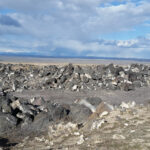Volcanic Rocks are fundamental components of our planet’s crust, formed from the fiery processes deep within the Earth. These rocks, also known as extrusive igneous rocks, originate from magma that erupts onto the surface as lava, or is explosively ejected as ash and volcanic debris. The Mojave Desert region, with its dramatic landscapes, offers exceptional examples of volcanic rocks and the diverse landforms they create. This area serves as a natural laboratory for understanding volcanism and its profound impact on shaping the Earth’s surface.
Understanding Volcanic Rocks
Volcanic rocks are born from the cooling and solidification of molten rock, or magma. When magma breaches the Earth’s surface, it is termed lava. The characteristics of volcanic rocks are highly dependent on the composition of the magma and the conditions of the eruption and cooling. Basalt, a common type of volcanic rock, is dark in color and relatively dense, often forming from lava flows. Rhyolite, another volcanic rock, has a composition similar to granite but is fine-grained, typically resulting from explosive eruptions and ash deposits. Tuff is a rock type formed from consolidated volcanic ash and fragments, representing the powerful ejecta of volcanic events.
Landforms Created by Volcanic Activity
Volcanic activity is responsible for a spectacular array of landforms. Volcanoes themselves are perhaps the most iconic, built up over time by successive eruptions of lava, ash, and cinders. However, volcanic processes also create subsurface features. Plutons are large bodies of intrusive igneous rock that solidify deep within the Earth’s crust. Smaller plutonic bodies exposed at the surface are sometimes called stocks. Dikes are formed when magma intrudes vertically into fractures, while sills are created by horizontal intrusions between rock layers. Laccoliths are blister-shaped intrusions that arch overlying strata. Erosion plays a crucial role in revealing these subsurface volcanic features over geological time.
Cinder Cones and Lava Flows in Mojave National Preserve
The Cinder Cones and Lava Flows National Natural Landmark Area within the Mojave National Preserve vividly illustrates recent volcanic activity. The most recent eruption in this region occurred approximately 8,000 years ago, a blink of an eye in geological terms. The remarkably well-preserved features here offer a glimpse into the immediate aftermath of volcanic events. Basalt is the dominant volcanic rock in this area, forming extensive black lava flows that retain textures indicative of their molten past. Cinder cones, composed of pyroclastic material, rise prominently from the landscape, marking vents where lava and cinders were ejected.
Successive eruptions have layered lava flows, creating a complex volcanic landscape. In some instances, lava traveled considerable distances, up to 10 kilometers from the eruption source. The rough, rubbly surfaces of these flows, along with the conical shapes of the cinder cones, are clear indicators of their volcanic origin.
Lava tubes, fascinating subterranean features, are also found in this area. These form when the surface of a lava flow cools and solidifies, while molten lava continues to flow beneath. Collapse of portions of the solidified surface can create entrances into these lava tubes, offering a unique opportunity to explore the plumbing systems of past lava flows.
Hole-in-the-Wall: Ancient Volcanic Area
In contrast to the relatively recent volcanism of the Cinder Cones area, Hole-in-the-Wall showcases evidence of much older, massive volcanic eruptions. Starting around 18.5 million years ago and continuing for several million years, this region experienced explosive eruptions of immense scale. These eruptions deposited thick layers of rhyolite tuff, a volcanic rock composed of welded volcanic ash and fragments. In some locations, these tuff beds reach thicknesses of hundreds of feet, indicating the magnitude of these events. The volcanic ash from these eruptions likely spread across a vast area, potentially blanketing much of the Great Basin.
Weathering processes have sculpted the rhyolite tuff at Hole-in-the-Wall into distinctive and picturesque formations. Tafoni, a type of honeycomb weathering, creates pitted and lacy textures on the rock surfaces, giving them a unique “cheese-like” appearance.
Further erosion has carved hoodoos, or rock spires, from the tuff, particularly in areas like Wild Horse Canyon near Hole-in-the-Wall. These irregular rock formations are testament to the long-term effects of weathering on volcanic tuff.
Weathering and Erosion of Volcanic Landscapes
Volcanic rocks, while initially appearing resistant, are constantly subjected to weathering and erosion, processes that gradually reshape volcanic landscapes over time. Ignimbrite deposits, formed from explosive volcanic flows, can be quite dense and resistant to erosion, often influencing drainage patterns and forming canyons. In contrast, cinder cones are relatively less durable and erode more rapidly. Studies in the Cinder Cones region indicate that cinder cones degrade significantly faster than lava flows and deeper-seated volcanic stocks. This differential erosion contributes to the diverse and evolving landscapes we observe in volcanic areas like the Mojave Desert, highlighting the dynamic interplay between volcanic rock types and erosional forces.
